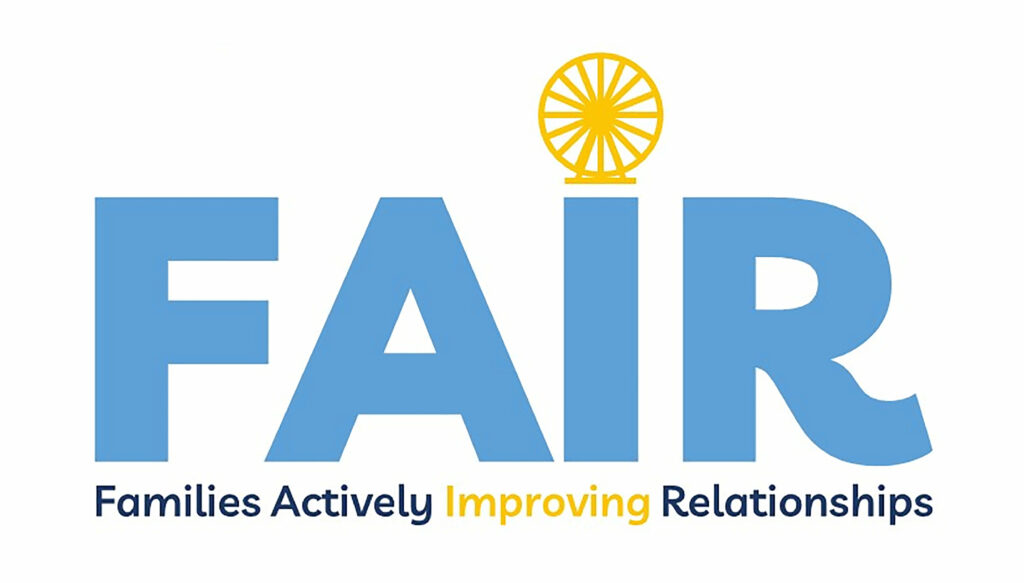Translational Science Benefits
Summary
As dual opioid and methamphetamine epidemics rise across the United States, more children entering the child welfare system have parents living with an opioid and/or methamphetamine use disorder.1–3 Also, more children involved with the child welfare system are entering into foster care due to parental substance use.4 Over the course of the opioid epidemic, children whose parents use illicit substances have increasingly been placed in foster care, yet fewer have returned home.5 Children return home later or less frequently if their parents abuse opioids and methamphetamine compared to children of families referred for other reasons.6,7

Despite these trends, programs to support parents through parenting skills interventions and substance use treatment are limited. To address this need, Dr. Lisa Saldana and her investigative team, in partnership with the Oregon Department of Health and Human Services and Lane County Child Welfare, developed the Families Actively Improving Relationships (FAIR) program. FAIR includes four core components: (1) Coordination with the child welfare system to ensure parents work towards goals of increasing child safety and permanency, (2) substance use treatment, (3) mental health treatment, and (4) case management to address ancillary needs (e.g., housing and employment). The FAIR team includes a clinical supervisor, a resource builder, and counselors who visit clients at home or in other convenient locations.8
FAIR initially began serving the Lane County, Oregon community through a small pilot study. After demonstrating positive outcomes, the project expanded to a Medicaid outpatient clinic.9 With funding from the federal Children’s Bureau, the research team demonstrated improved parenting skills, enhanced mental health, and successfully treated substance use for 99 parents involved with the child welfare system who were living with opioid and/or methamphetamine use disorder.10 Parents engaged with FAIR at higher rates than traditional substance use outpatient treatments.9,10
Now, with support from the NIH Helping to End Addiction Long-term initiative, the research team is implementing FAIR in partnership with county health departments and local clinical sites across three low-resourced, rural districts in Oregon. This phase will test the effectiveness of an adaptation of the intervention, known as PRE-FAIR, aimed at preventing opioid and methamphetamine use disorders among 240 parents and reducing the risk of child placement into foster care.
Significance
Children who experience maltreatment followed by involvement in the child welfare system are at increased risk for lifelong poor health outcomes such as unstable housing, underemployment, substance use, poor health, and early death. Supporting parents through parenting skills intervention, substance use treatment, and timely reunification can lessen negative outcomes for children.2 FAIR integrates these services into a single intervention to address the complex needs of parents who are involved with the child welfare system and are living with or at risk for opioid and/or methamphetamine use disorder. FAIR has reduced parental opioid and methamphetamine use, mental health symptoms, and parenting risk, and improved stability. FAIR helps families remain together and successfully reunite, increasing opportunities for healthy child development in a stable home environment. FAIR is rated as promising evidence with high relevance for child welfare by the California Evidence-Based Clearinghouse (CEBC), which informs the use of evidence-based child welfare practices for child welfare systems and community-based programs.11
Interventions like FAIR also have the potential to reduce the economic burden caused by the strained child welfare system. Parental substance abuse costs between $2.65 and 3 billion annually, including the cost to the child welfare and foster care systems.12 FAIR also has the potential to prevent opioid and/or methamphetamine use disorder among parents at elevated risk, which could help fight the opioid epidemic and increase in methamphetamine use.
Benefits
Demonstrated benefits are those that have been observed and are verifiable.
Potential benefits are those logically expected with moderate to high confidence.
FAIR provided integrated mental health and substance use treatment, parenting skill building, and case management to address ancillary needs of parents involved with the child welfare system who were living with opioid and/or methamphetamine use disorder. demonstrated.
Clinical
FAIR provided mental health and substance use treatment, parenting skill development, and case management through community clinics and local health departments. demonstrated.
Community
FAIR significantly decreased substance use and improved mental health among parents. demonstrated.
Community
FAIR improved access to evidence-based substance use and mental health treatment, parenting skills development, and case management by providing services in community settings—meeting parents in places that worked for them. demonstrated.
Community
FAIR increased engagement between parent and clinicians, improving evidence-based practices such as harm reduction and cognitive behavioral strategies. demonstrated.
Community
FAIR improved quality of life among referred parents by reducing substance use, improving mental health and parenting, and increasing stability. demonstrated.
Community
By improving parental health and stability, FAIR has the potential to improve child health and development outcomes. potential.
Community
FAIR can be delivered under a billable structure when implemented under managed care organizations open to tailored fee schedules. demonstrated.
Economic
FAIR will reduce cost of services for parents involved in child welfare, by providing effective, integrated, and time-limited evidence-based care. potential.
Economic
FAIR will reduce healthcare costs by reducing substance use and improving mental health. potential.
Economic
FAIR was featured as an example program by the Children’s Bureau for addressing parental methamphetamine and opioid use and child neglect.8 demonstrated.
Policy
FAIR is rated as a promising intervention by the California Evidence Based Clearinghouse.11 demonstrated.
Policy
This research has clinical, community, economic, and policy implications. The framework for these implications was derived from the Translational Science Benefits Model created by the Institute of Clinical & Translational Sciences at Washington University in St. Louis.
Clinical
As a treatment model, FAIR created an integrated approach that combined substance use treatment, parenting skill building, and case management to address ancillary needs of parents involved with the child welfare system who were living with opioid and/or methamphetamine use disorder. This integrated approach is necessary to address the complex needs of these individuals.
Community
FAIR provides substance use and mental health treatment, parenting support, and case management for to satisfy unmet needs of parents. FAIR increases access to these integrated services by ensuring that counselors are available 24/7 and are willing to engage with parents during counseling sessions in the community—in places most convenient to the parent and where the parent spends time. FAIR’s model increases engagement between parents and clinicians, improving the quality evidence-based practices such as harm reduction and cognitive behavioral strategies. FAIR has reduced substance use, reduced intravenous drug use, improved parenting skills, improved mental health, and increased stability in terms of housing and employment.10 These changes improve quality of life and life expectancy for the parents and ultimately for their children who benefit developmentally from a stable family home. FAIR also has the potential to prevent opioid and/or methamphetamine use disorder among parents at elevated risk. Currently, an adapted prevention model of FAIR is being implemented and evaluated in regions of a single state in which access to services for parents is limited.
Economic
FAIR works with local Medicaid providers to ensure that FAIR clinics receive reimbursement for services provided, creating a feasible billing structure for providing such integrated services. FAIR also has the potential to decrease the cost of care for people with opioid and/or methamphetamine use disorders. Because FAIR engages and retains more participants than traditional treatment models, services are more likely to be received, and parents consistently experience better outcomes up to two years after participation.10 The cost of treating a FAIR client decreases over the approximate 9 months of treatment and is less than the average cost of standard treatment in the United States.10 FAIR also has the potential to meet eligibility as an approved program for the Families First Prevention Services Act. If endorsed, adoption of FAIR could be supported with Title IV-E Waiver dollars by states, further reducing costs to states.
Policy
FAIR is recognized by the California Evidence-Based Clearinghouse for Child Welfare (CEBC) as an evidence-based practice for child welfare settings.11 CEBC recognition provides child welfare professionals and statewide systems across the US with an integrated intervention that demonstrates promising research evidence of its effectiveness. FAIR research studies have occurred in real-world settings, and the implementation of the intervention in such settings has been evaluated. FAIR also was featured as an example program to address parental methamphetamine and opioid use and child neglect by the Children’s Bureau in the Department of Health and Human Services.8
Lessons Learned
The success of the FAIR program relies on strong community partnerships. From its inception, the research team developed FAIR with input from child welfare leaders, frontline workers, and involved families. Local partners who were committed to creating an evidence-based treatment for families in need of services made rigorous evaluation possible. Child welfare and other community service partners also collaborated with FAIR team members. Their willingness to find creative solutions to family needs made clinical effectiveness possible. Community partners also donated to support treatment incentives, which is a critical component for evidence-based strategies.
The research team also used creative engagement strategies to engage and retain parents who experience high barriers to treatment access, such as with parents at times and places that are meaningful and convenient to them (e.g., home, school on registration day), providing a snack or beverage, or offering assistance with a meaningful task (e.g., putting together a crib). To rapidly modify behaviors, the team conducted frequent (at times daily) sessions, urinalysis, behavioral observations, and feedback. The use of frequent interactions within community settings allowed for social learning strategies including modeling and natural reinforcement.
- Volkow N. Rising stimulant deaths show that we face more than just an opioid crisis. National Institute on Drug Abuse website. Published November 12, 2020. Accessed September 14, 2021.
- US Department of Health and Human Services. Child Maltreatment 2019. US Dept of Health and Human Services, Administration for Children & Families, Children’s Bureau; 2021. Accessed September 14, 2021.
- Child welfare and substance use. Office of the Assistant Secretary for Planning and Evaluation (ASPE) website. Accessed September 14, 2021.
- Ghertner R, Waters A, Radel L, Crouse G. The role of substance use in child welfare caseloads. Child Youth Serv Rev. 2018;90:83-93. doi:10.1016/j.childyouth.2018.05.015
- Sanmartin MX, Ali MM, Meinhofer A. Parental drug use and family reunification. Psychiatr Serv. 2021;72(6):728-728. doi:10.1176/appi.ps.202000388
- Grella CE, Needell B, Shi Y, Hser YI. Do drug treatment services predict reunification outcomes of mothers and their children in child welfare? J Subst Abuse Treat. 2009;36(3):278-293. doi:10.1016/j.jsat.2008.06.010
- Akin BA, Brook J, Lloyd MH. Examining the role of methamphetamine in permanency: a competing risks analysis of reunification, guardianship, and adoption. Am J Orthopsychiatry. 2015;85(2):119-130. doi:10.1037/ort0000052
- US Department of Health and Human Services. Acts of Omission: An Overview of Child Neglect. US Dept of Health and Human Services, Administration for Children & Families, Children’s Bureau; 2018. Accessed November 5, 2021.
- Saldana L. An integrated intervention to address the comorbid needs of families referred to child welfare for substance use disorders and child neglect. Child Welfare. 2015;94(5):167-186.
- Saldana L, Chapman JE, Campbell M, Alley Z, Schaper H, Padgett C. Meeting the needs of families involved in the child welfare system for parental substance abuse: outcomes from an effectiveness trial of the families actively improving relationships program. Front Psychol. 2021;12:2592. doi:10.3389/fpsyg.2021.689483
- Families Actively Improving Relationships (FAIR). The California Evidence-Based Clearinghouse for Child Welfare website. Accessed September 14, 2021.
- Crowley DM, Connell CM, Jones D, Donovan MW. Considering the child welfare system burden from opioid misuse: research priorities for estimating public costs. Am J Manag Care. 2019;25(13 Suppl):S256-S263.

